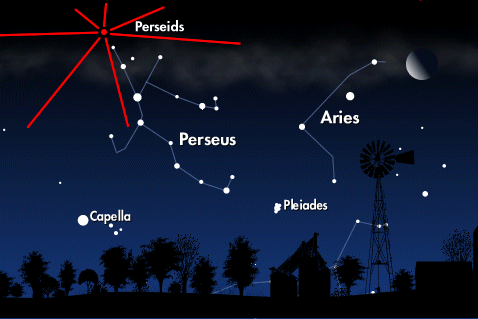Perseid Shower 2010 – Meteor Shower Guide
This year’s display of the annual perseids shower looks like being one of the best for many years and promises to be particularly spectacular over the next couple of days: August 12th and 13th 2010.
The last time the Perseid meteor shower occurred during a run of clear moonless nights was back in 2007. This is because only once every three years does the same phase of the Moon return to roughly the same date each month (2.2 days earlier, on average). So in 2010 we’re on for moonless perseid showers and with clear skies, the shower could produce a display of up to 80 meteors per hour according to Nasa.
Perseid Meteor Shower?
The Perseid meteor shower is caused by debris from the comet Swift-Tuttle. This huge comet hurtles through the inner part of our Solar System once every 133 years and leaves behind a trail of dust and gravel.
When Earth passes through the debris, specks hit our atmosphere at 140,000mph and disintegrate in flashes of light and that is the Meteor Shower that you see in the sky.
Where & how to watch the Perseid showers 2010:

The meteors are called the Perseids because they appear to fly out of the constellation Perseus, so that is where you need to be looking into the sky.
The shower lasts for many days, but this year’s peak should occur during a half-day-long window centered on 1:00 Universal Time on August 13th, which is ideal timing for skywatchers in Eurasia. For North Americans, the best viewing will probably be late Thursday night and early Friday morning, August 12-13, or possibly the night before. In the UK, the Perseid Shower display will start as soon as it gets dark at around 10pm, peaking between midnight and 1am (local time).
To make sure that you get the best view, you need to go somewhere where there is as little light pollution as possible even if you can’t you should still be able to see about 10 shooting stars an hour at the peak. Out in the countryside where the skies are darker will be much better, where between 60 to 100 an hour should be seen.
The great thing about a meteor shower like Perseids is that you don’t need a telescope to get a great view, in fact they are best seen with the naked eye. Although whilst you are outside watching the skies, I highly encourage you to take out your pair of binoculars, you will be amazed at just how much brighter and how many more stars you can view through them. For more, take a look at my guide to the best binoculars for Astronomy.

 Article | Posted by Best Binocular Reviews
Article | Posted by Best Binocular Reviews 
 Categories:
Categories:  Tags:
Tags: 
